- europages
- >
- COMPANIES - SUPPLIERS - SERVICE PROVIDERS
- >
- stainless steel tubing
Results for
Stainless steel tubing - Import export

CARL FRIEDRICH USBECK KG
Germany
stainless steel*finger grip*length 130 mm*up to 30 mm Ø
Request for a quote
RK ROSE+KRIEGER GMBH
Germany
A flexible and cost-effective way of connecting tubes to each other reliably and stably. RK Rose+Krieger developed the precision-cast stainless steel tube connectors specially for heavy loads and impact-resistance. The high-strength tube connectors are resistant to high temperatures and corrosion, and are engineered for dynamic loads. An electrochemical passivation – the tube connectors are electropolished in a final working step – makes them more resilient and resistant to acids than elements made of untreated stainless steel. As a result they are particularly resistant to cleaning with aggressive cleaning agents or hot water from high-pressure cleaners, and ideally suitable for use in packaging machines or for feeding technology in plants in the chemicals industry. Stainless steel clamp connectors are tough. Stainless steel clamps are particularly important for users working in the fields of chemical and food technology.
Request for a quote
CARL FRIEDRICH USBECK KG
Germany
stainless steel*for 50 test tubes
Request for a quote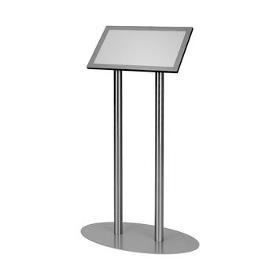
VKF RENZEL GMBH
Germany
Flexible information terminal for the POS / POI consisting of a 21.5 inch multi-touch PC with Android operating system and a stand. The powerful processor enables many individual application possibilities "stand-alone" or internet-based. The stand, made of an oval silver-coloured steel plate and 2 brushed stainless steel tubes, ensures a secure stand.
Request for a quote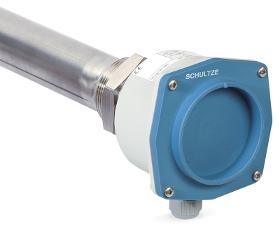
FRIEDRICH SCHULTZE GMBH
Germany
Screw-in heaters are versatile and intended for heating liquid media in industrial and commercial applications. When selecting, the specific surface load permitted for the respective medium must be observed and checked by the customer. EHK G2 are mainly used for heating hydraulic oil in containers in which the replacement of the heating cartridge without draining the medium must be possible. Ceramic heating cartridge in stainless steel tube ø 50mm, material-no. 1.4512 or material-no. 1.4404. G2″ thread SW70 welded from V2A. Terminal box made of PA6-GF30, impact-resistant and oil-resistant, degree of protection IP66/67. Unheated zone 50mm, surface load 1,5 W/cm², voltage 230/400 V. Special versions on request.
Request for a quote
TRANSFLUID® MASCHINENBAU GMBH
Germany
There are many good reasons to separate tubes chiplessly. And first of all, of course, the cleanliness. Precision and output, too, are not insignificant. Our chipless orbital cutting machines make precise cutting results possible. Your tubes can be formed immediately afterwards. That saves time and money. Technical specifications: Separation efficiency: max. Ø 28 x 2 mm for stainless steel tubes Shortest separation length: — 25 mm (without pull apart) — 55 mm (with pull apart) Separation efficiency: up to 2,000 pcs per hour
Request for a quote
FRIEDR. FREEK GMBH
Germany
Screw-in Tubular Heaters are the standard solution for all heating processes with liquids or gas. The heater is installed in a tank or a tube system by the G1½" screw fitting. The IP54 connection head, fitting and tubular heater consists of stainless steel. The tube sheath material 1.4529 is resistant to sulphite, phosphors and hydrochloride media.
Request for a quote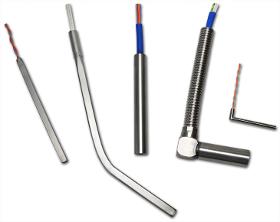
FRIEDR. FREEK GMBH
Germany
Occasionally also these terms are used for cartridge heates: heating cartridge, insertion heaters, spiral cartridge heaters. As a rule cartridge heaters consist of a cylindrical stainless steel tube and thus provide a high corrosion prevention. There is a heating wire inside which is wound onto a ceramic core. The number of coils varies depending on the power. In order to avoid a short-circuit, the cartridge heater is filled with magnesium oxide and compressed afterwards. Highly compacted they reach a surface watt density of up to 50 W/cm² and withstand highest stress. In the plastics industry cartridge heaters are used in hot runners in order to temper thermoplasts during injection moulding processes. Other areas of applications for process heat are e. g. packaging, diecasting or continuous casting in which zinc or aluminium are processed. Further applications are to be found in mechanical as well as medical and laboratory engineering.
Request for a quote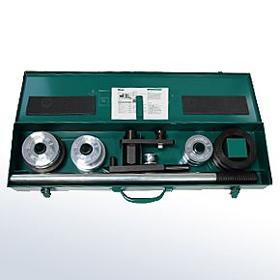
WALTER STAUFFENBERG GMBH & CO. KG
Germany
When used with a commercially available vice, STAUFF manual tube benders, type TUB-MA, enable common hydraulic tubes to be bent manually. They are suitable for steel and stainless steel tubes with diameters of 6, 8, 10, 12, 14, 15, 16, 18 and 22 mm with a defined minimum wall thickness. In addition to the metric version, a model for handling imperial tubes with diameters of between 1/4 and 7/8 inches is also available. The eight bending rollers – six in the imperial version – ensure maximum wear. A scale lasered onto the bending rollers enhances the accuracy of the required bending angle with superior precision. The manual tube bender is supplied with all the necessary components and multilingual instructions for use as a complete kit in a high-quality steel case. Features and advantages Technical Data
Request for a quote
WALTER STAUFFENBERG GMBH & CO. KG
Germany
Performance The patented STAUFF Form tube forming system is without doubt one of the most high-performing solutions currently available on the market for connecting metric sized tubes. Apart from its simplicity, it also provides a maximum level of safety, reliability and reproducibility. STAUFF Form has been designed as standard for seamless cold-drawn precision steel tubes as well as stainless steel tubes with dimensions between 6 x 1.5 mm and 42 x 4 mm in the Light Series and between 6 x 1.5 mm and 38 x 6 mm in the Heavy Series. Parameters for alternative materials (copper, brass, CuNiFe, Tungum etc.) can be added by the manufacturer, if required. System Design and Components The system is based on standard parts and consists of only four key components: The STAUFF Form Ring with an integrated and thus undetachable elastomeric sealing is slid onto the tube end, which has previously been mechanically contoured. This creates a positive-locking connection that provides a...
Request for a quote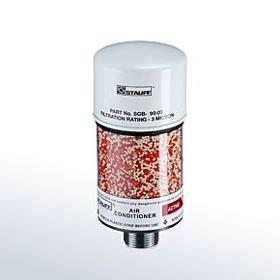
WALTER STAUFFENBERG GMBH & CO. KG
Germany
Combination of air breather and water removal filter Features ▪ Available in 4 different sizes ▪ Diameter of Ø100 mm / Ø3.94 in or Ø130 mm / Ø5.12 in ▪ Refillable with drying agent (non-toxic ZR gel grain) or a mix of drying agent and active carbon ▪ Drying agent capable in changing colour from Red to orange with increasing moisture ▪ Without dangerous substances according to EC Council directives 99/45/EC and 2001/60/EC ▪ Replaceable air filter element SGB ▪ Connection: Male BSP thread (ISO 228) on Stainless Steel tube ▪ Available with adaptor plate to simplify installation and to enable the use of a visual contamination indicator ▪ Adaptor plate ▪ Visual contamination indicator ▪ Drying agent refilling material ▪ Active carbon refilling material ▪ Replacement air filter element
Request for a quote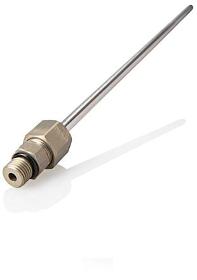
PTEC PRESSURE TECHNOLOGY GMBH
Germany
Service pressure: 0-26 Mpa Service temperature: -40°C up to 85°C Reliable in filling and operation direction Compact design Stainless steel, Aluminium HC-plated, corrosion resistant All seals are suitable for CNG EC 79 is planned The fitting is equivalent of heavy metal regulation Burst pressure: > 200 Mpa, 20° Curved stainless steel tubes from 6, 8,10mm and 3/8", ½" Tightness: 1x10-5mbar l/s, 20°C, 100% He
Request for a quote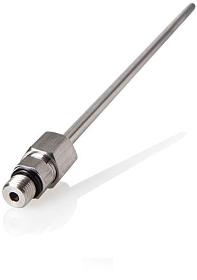
PTEC PRESSURE TECHNOLOGY GMBH
Germany
Service pressure: 0-26 Mpa Service temperature: -40°C up to 85°C Reliable in filling and operation direction Compact design Stainless steel, Aluminium HC-plated, corrosion resistant All seals are suitable for CNG EC 79 is planned The fitting is equivalent of heavy metal regulation Burst pressure: > 200 Mpa, 20° Curved stainless steel tubes from 6, 8,10mm and 3/8", ½" Tightness: 1x10-5mbar l/s, 20°C, 100% He
Request for a quote
ABS SAFETY GMBH
Germany
To prevent an ABS-Lock III anchorage point from being accidentally bent during the pre-tensioning process, it can be reinforced using one of our specially designed stainless steel ABS-Lock III Supporting Tubes (Ø 42 mm). Simply contact us to check whether your anchorage point can be upgraded prior to installation. Supporting tube for Ø 16 mm posts Designed for usage as a corner or end post in a lifeline system Includes an energy absorber
Request for a quote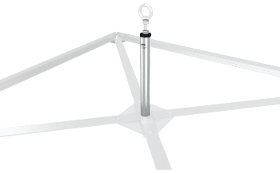
ABS SAFETY GMBH
Germany
Reinforce your ABS Weight OnTop Double anchorage device with this optional supporting tube (Ø 42 mm) to withstand the increased tension exerted on the corner and end supports in a lifeline system. This device comes with an extra energy absorber. Supporting tube for Ø 16 mm posts Required for usage as a corner or end post in a lifeline system Includes an energy absorber
Request for a quote
TWK-ELEKTRONIK GMBH
Germany
The displacement transducers operate according to the principle of run time measurement between two points of a magnetostrictive waveguide. One point is determined by a moveable position magnet, whose distance from the null point corresponds to the section to be measured. The run time of an emitted impulse is directly proportionate to this section. Conversion to a measuring signal takes place in the downstream electronics. The waveguide is housed in a pressure-resistant stainless steel tube or extruded profile. To the rear of this is a die-cast aluminium housing containing the electronics in SMD technology. In the rod version, the position magnet is located in a ring, which is guided over the rod without contact. In the profile version, it is located either in a slider, which is linked to the moving part of the machine via a ball joint, or it moves as a liftable position magnet, without wear, over the profile.
Request for a quoteDo you sell or make similar products?
Sign up to europages and have your products listed

TWK-ELEKTRONIK GMBH
Germany
The displacement transducers operate according to the principle of run time measurement between two points of a magnetostrictive waveguide. One point is determined by a moveable position ring, whose distance from the null point corresponds to the section to be measured. The run time of an emitted impulse is directly proportionate to this section. Conversion to a displacement signal takes place in the downstream electronics. The waveguide is housed in a pressure-resistant stainless steel tube or extruded profile. To the rear of this is a die-cast aluminium housing containing the electronics in SMD technology. In the rod version, the position magnet is located in a ring, which is guided over the rod without contact. In the profile version, it is located either in a slider, which is linked to the moving part of the machine via a ball joint, or it moves as a liftable position magnet, without wear, over the profile.
Request for a quote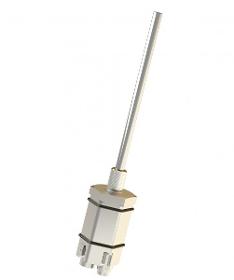
TWK-ELEKTRONIK GMBH
Germany
The displacement transducers operate according to the principle of run time measurement between two points of a magnetostrictive waveguide. One point is determined by a moveable position magnet, whose distance from the null point corresponds to the section to be measured. The run time of an emitted impulse is directly proportionate to this section. Conversion to a digital measuring signal takes place in the downstream electronics. The waveguide is housed in a pressure-resistant stainless steel tube or extruded profile. To the rear of this is a die-cast aluminium housing containing the electronics in SMD technology. In the rod version, the position magnet is located in a ring, which is guided over the rod without contact. In the profile version, it is located either in a slider, which is linked to the moving part of the machine via a ball joint, or it moves as a liftable position magnet, without wear, over the profile.
Request for a quote
TWK-ELEKTRONIK GMBH
Germany
The displacement transducers operate according to the principle of run time measurement between two points of a magnetostrictive waveguide. One point is determined by a moveable position magnet, whose distance from the null point corresponds to the section to be measured. The run time of an emitted impulse is directly proportionate to this section. Conversion to a digital measuring signal takes place in the downstream electronics. The waveguide is housed in a pressure-resistant stainless steel tube or extruded profile. To the rear of this is a die-cast aluminium housing containing the electronics in SMD technology. In the rod version, the position magnet is located in a ring, which is guided over the rod without contact. In the profile version, it is located either in a slider, which is linked to the moving part of the machine via a ball joint, or it moves as a liftable position magnet, without wear, over the profile.
Request for a quote
TWK-ELEKTRONIK GMBH
Germany
The displacement transducers operate according to the principle of run time measurement between two points of a magnetostrictive waveguide. One point is determined by a moveable position ring, whose distance from the null point corresponds to the section to be measured. The run time of an emitted impulse is directly proportionate to this section. Conversion to a displacement signal takes place in the downstream electronics. The waveguide is housed in a pressure-resistant stainless steel tube or extruded profile. To the rear of this is a die-cast aluminium housing containing the electronics in SMD technology. In the rod version, the position magnet is located in a ring, which is guided over the rod without contact. In the profile version, it is located either in a slider, which is linked to the moving part of the machine via a ball joint, or it moves as a liftable position magnet, without wear, over the profile.
Request for a quote
TWK-ELEKTRONIK GMBH
Germany
The displacement transducers operate according to the principle of run time measurement between two points of a magnetostrictive waveguide. One point is determined by a moveable position magnet, whose distance from the null point corresponds to the section to be measured. The run time of an emitted impulse is directly proportionate to this section. Conversion to an analogue measuring signal takes place in the downstream electronics. The waveguide is housed in a pressure-resistant stainless steel tube or extruded profile. To the rear of this is a die-cast aluminium housing containing the electronics in SMD technology. Electrical connection is implemented via a circular connector. In the rod version, the position magnet is located in a ring, which is guided over the rod without contact. In the profile version, it is located either in a slider, which is linked to the moving part of the machine via a ball joint, or it moves as a liftable position magnet, without wear, over the profile.
Request for a quote
TWK-ELEKTRONIK GMBH
Germany
The displacement transducers operate according to the principle of run time measurement between two points of a magnetostrictive waveguide. One point is determined by a moveable position magnet, whose distance from the null point corresponds to the section to be measured. The run time of an emitted impulse is directly proportionate to this section. Conversion to a measuring signal takes place in the downstream electronics. The waveguide is housed in a pressure-resistant stainless steel tube or extruded profile. To the rear of this is a die-cast aluminium housing containing the electronics in SMD technology. In the rod version, the position magnet is located in a ring, which is guided over the rod without contact. In the profile version, it is located either in a slider, which is linked to the moving part of the machine via a ball joint, or it moves as a liftable position magnet, without wear, over the profile.
Request for a quote
TWK-ELEKTRONIK GMBH
Germany
The displacement transducers operate according to the principle of run time measurement between two points of a magnetostrictive waveguide. One point is determined by a moveable position magnet, whose distance from the null point corresponds to the section to be measured. The run time of an emitted impulse is directly proportionate to this section. Conversion to a digital measuring signal takes place in the downstream electronics. The waveguide is housed in a pressure-resistant stainless steel tube or extruded profile. To the rear of this is a die-cast aluminium housing containing the electronics in SMD technology. Electrical connection is implemented via a circular connector. In the rod version, the position magnet is located in a ring, which is guided over the rod without contact. In the profile version, it is located either in a slider, which is linked to the moving part of the machine via a ball joint, or it moves as a liftable position magnet, without wear, over the profile
Request for a quote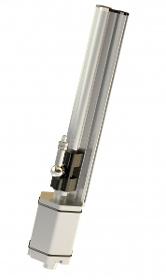
TWK-ELEKTRONIK GMBH
Germany
The displacement transducers operate according to the principle of run time measurement between two points of a magnetostrictive waveguide. One point is determined by a moveable position magnet, whose distance from the null point corresponds to the section to be measured. The run time of an emitted impulse is directly proportionate to this section. Conversion to a digital measuring signal takes place in the downstream electronics. The waveguide is housed in a pressure-resistant stainless steel tube or extruded profile. To the rear of this is a die-cast aluminium housing containing the electronics in SMD technology. Electrical connection is implemented via a circular connector. In the rod version, the position magnet is located in a ring, which is guided over the rod without contact. In the profile version, it is located either in a slider, which is linked to the moving part of the machine via a ball joint, or it moves as a liftable position magnet, without wear, over the profile.
Request for a quote
TWK-ELEKTRONIK GMBH
Germany
The displacement transducers operate according to the principle of run time measurement between two points of a magnetostrictive waveguide. One point is determined by a moveable position magnet, whose distance from the null point corresponds to the section to be measured. The run time of an emitted impulse is directly proportionate to this section. Conversion to an analogue measuring signal takes place in the downstream electronics. The waveguide is housed in a pressure-resistant stainless steel tube or extruded profile. To the rear of this is a die-cast aluminium housing containing the electronics in SMD technology. Electrical connection is implemented via a circular connector. In the rod version, the position magnet is located in a ring, which is guided over the rod without contact. In the profile version, it is located either in a slider, which is linked to the moving part of the machine via a ball joint, or it moves as a liftable position magnet, without wear, over the profile.
Request for a quote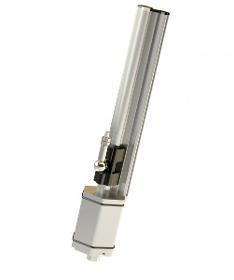
TWK-ELEKTRONIK GMBH
Germany
The displacement transducers operate according to the principle of run time measurement between two points of a magnetostrictive waveguide. One point is determined by a moveable position magnet, whose distance from the null point corresponds to the section to be measured. The run time of an emitted impulse is directly proportionate to this section. Conversion to an analogue measuring signal takes place in the downstream electronics. The waveguide is housed in a pressure-resistant stainless steel tube or extruded profile. To the rear of this is a die-cast aluminium housing containing the electronics in SMD technology. Electrical connection is implemented via a circular connector. In the rod version, the position magnet is located in a ring, which is guided over the rod without contact. In the profile version, it is located either in a slider, which is linked to the moving part of the machine via a ball joint, or it moves as a liftable position magnet, without wear, over the profile.
Request for a quote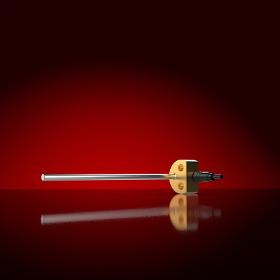
LENORD, BAUER & CO. GMBH
Germany
Conventional thermometers measure the temperature by means of length or volume change of a material, and are only suitable as display instrument. Temperature sensors from Lenord+Bauer use resistance thermometers that feature an almost temperaturelinear resistance curve, and output the resulting measurement data as electrical signal. They are suitable for a measurement range from 40 °C to +250 °C. A thin stainless steel tube protects the electronics from dirt, humidity and corrosion, allowing the sensors to meet the requirements of protection class IP 68. The sensors are in compliance with fire protection standards EN 45545 and are typetested according to EN 50155. • Platinum resistance thermometer Pt100 / Pt1000 • Measuring tube lengths from 30 mm to 140 mm • Connection with 2, 3 or 4wire technology • Fire behaviour according to DIN 5510 and NF F16101 • Custom configuration
Request for a quote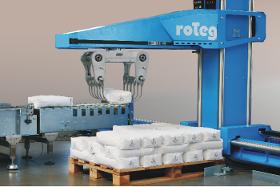
ROTEG AG ROBOTER TECHNOLOGIE
Germany
The palletizing robot system PARO® has a modular structure. This is how the palletizing room can be optimally adapted to the palletizing task – even afterwards. The spectrum ranges from standard single place cells which are not bigger than the pallet itself, to palletizing systems with twelve or more palletizing stations. All of this is easily determined by a correspondingly long horizontal axis. The palletizing robot PARO® is a four-axis robot whose axis have a special guide system: Profiled, teflon coated Vulkollanrollers run on polished stainless steel tubes. This system has proven itself to be robust and maintenance free. With this simple system technology a lot of industrial handling processes are economically automated in different performance areas. The PARO® is durable and also suitable for the use in extreme enviroments. All in all the robot offers a good price-performance ratio.
Request for a quoteResults for
Stainless steel tubing - Import exportNumber of results
56 ProductsCompany type
Category
- Pipe and tube fittings - ferrous metal (24)
- Sensors (13)
- Pipes and tubes, steel (2)
- Electroheat - machines and equipment (2)
- Laboratory equipment and instruments (2)
- Heating, industrial - installations and equipment (1)
- Palletising machinery (1)
- Plate glass and mirrors (1)
- Shearing machine tools (1)
- Wrapping and outer-wrapping machinery (1)
